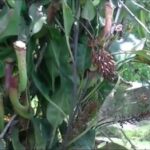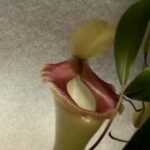As an Amazon Associate, this site earns commissions from qualifying purchases. For more details, click here.
Nepenthes rafflesiana is a lowland pitcher plant endemic throughout Southeast Asia. In the wild this plant reaches up to 50 feet (15 meters), but those sold for homes and gardens grow at a more manageable 4-5 inches (approx. 8 cm). In this in-depth guide you will discover the right way to care for this nepenthes.
Nepenthes rafflesiana should be cultivated in nutrient-free soil at 68-85 F and at least 80% humidity. Warm but indirect sunlight is best and the soil should be moist. Water n. rafflesiana from the top and do not use the tray method.
Nepenthes Rafflesiana Care Sheet
| Soil | 3:1:1 long sphagnum moss, orchid bark, perlite, keep soil moist |
| Water | Spring, distilled, reverse osmosis, rainwater |
| Light | 6-8 hours partial light, indoor lights are fine |
| Food | Bugs, worms, fish pellets, fish flakes |
| Temperature | 50-85 F (10-30 C ) |
| Humidity | 80-100% |
| Dormancy | No |
| Propagation | Stem cuttings, seeds |
Soil
These pitcher plants are usually sold with soil and pot so no need to worry about getting the mix right. If you want to do a custom mix or grow a new nepenthes, use only low nutrition, lightly acidic media like the Jungle House Potting Mix.
Nepenthes rafflesiana grows best in neutral to lightly acidic media. A good soil mix is 3 parts long sphagnum moss with 1 part orchid bark and 1 part perlite. The standard carnivorous plant mix of 50/50 perlite and peat will also work here.
The easiest way is to buy premixed soil for carnivorous plants. They are available online and are compatible with n. rafflesiana. If the potting media is labeled as for carnivorous plants then it will work with nepenthes.
You can also mix and match other media like peat and perlite, LFS and perlite with silica sand and so on. You can start with 1:1 and try others like 2:1 or 3:1. Experiment only if you already have experience growing n. rafflesiana as the results can vary widely.
Pot Container
Vendors usually ship the plant in a pot, though sometimes they give you the option to order a basket or another container. A pot will do nicely for beginners. Just leave it on a bright windowsill and give it time to grow.
Nepenthes rafflesiana are usually cultivated in 3-4 inch pots. But you can also use use a terrarium like this one from Waytoeast, a greenhouse or hanging baskets.
Nepenthes rafflesiana are repotted every two years. You can do this anytime since the plant does not go dormant. But it is best to do this in early spring before new leaves grow. Though nepenthes does not go dormant, its growth can slow in winter. You can take advantage of this to repot the plant.
You can also hang your pitcher plant, a common practice among growers. If you prefer to grow n. rafflesiana indoors you can go with a terrarium. With proper light, water, humidity and feeding, n. rafflesiana should grow without problems.
Water
N. rafflesiana needs regular watering during its growth period. Use a spray bottle and water as often as necessary to maintain soil moisture. You can mist the leaves to keep them from drying up.
Lowland pitcher plants like n. rafflesiana should be watered to keep the soil moist but not soggy. Use only purified, spring or rainwater. You can mist the plant and leave a small amount of water in its pitchers. Do not sit nepenthes rafflesiana in water.
Some growers put a small amount of water in the pitchers. Do this only when it is hot and your nepenthes seems to be having problems producing liquids. Do not fill it up, just a small volume will do.
Do not use the tray method. N. rafflesiana requires plenty of water but it does not respond well to bottom watering . Water from the top often if the soil dries quickly. You can also install a fogger or humidifier to increase moisture.
Light
Keep nepenthes rafflesiana in partial sunlight. A south facing windowsill is ideal. These pitcher plants can also grow in terrariums with artificial lights.
The simplest set up is to place the plant on a windowsill, south facing if you are in the northern hemisphere and north facing if you are at the southern hemisphere. This setup offers maximum light for your nepenthes without causing sunburn.
Lowland nepenthes need lots of sun but it must be partially shaded. Direct sunlight can burn leaves and dry up pitchers. Provide as much light as possible but without directly exposing it to the sun.
Artificial lights. To grow nepenthes rafflesiana in a terrarium, you need plant grow lights. Set up the fixtures according to the instructions and place it 15 inches (40 cm) above the plant.
Aside from lighting you have to make sure the terrarium has sufficient ventilation, the right temperature and humidity. You have to feed the plant regularly because it has no way to catch insects.
Temperature
Temperature affects all plants and nepenthes are no exception. The closer the climate is to the natural habitat of the plant, the healthier it will grow.
Nepenthes rafflesiana should be grown in 50-85 F (10-30 C ) temperature. The ideal daytime temperature is 68 F (20 C).
Similar to other lowland nepenthes, n. rafflesiana prefers warm weather but not too hot. These plants benefit from sunlight but too much of it is not good. The more intense the light is, the higher the temperature usually goes, so provide partial cover if possible.
Temperature is a concern if your nepenthes is in a terrarium or greenhouse. They can be effective in maintaining a healthy environment, but these enclosures can get too hoot or lack ventilation.
If your nepenthes is outdoors make sure it is not fully exposed to the sun. Morning sunshine is good for these plants, but be wary of the midday sun. Shade the plant if the temperature starts climbing into the 90s.
Humidity
Nepenthes rafflesiana prefers high humidity from 80-100%. Do not allow the humidity rate to drop below 50%.
The optimum environment is sunny, warm with high humidity. If the humidity level is at last 50% the plant will thrive, growing quickly and produce healthy traps. If humidity is too low nepenthes plants tend to dry out and weaken.
If your n. rafflesiana is indoors it is easier to control humidity. Moving the plant into a cooler room or installing a humidifier is enough. Watering more often keeps the soil moist during summer.
Humidity is important for all pitcher plants. A humidifier lets you do some fine tuning, but having the right environment is usually enough. If your nepenthes is under bright, indirect light and the temperature is between 50-95 F, the humidity rate is likely going to be at least 50%.
Nutrition and Feeding
While pitcher plants can make their own food, nutrition is still important. Regardless where your nepenthes rafflesiana grows, make sure it gets sufficient nutrition.
Nepenthes rafflesiana should eat at least one insect every two weeks. Larger pitcher plants can eat a few small bugs every week.
Pitcher plants can also feed on freeze dried mealworms as well as fish food. Their food source does not have to be just insects. Both mealworms and fish beta pellets contain the nutrients that n. rafflesiana requires so they are suitable.
You can also give a small amount of Maxsea fertilizer to nepenthes. Add 1/4 teaspoon Maxsea to a gallon of water. Mix thoroughly and give a small amount to one of the pitchers. Do this every two weeks. If the plant responds well, continue it.
Dormancy
Nepenthes rafflesiana does not need dormancy. The plant grows the entire year and must be protected from winter freezing. Keep the plant above 50 F at all times.
Some pitcher plants go through dormancy and reemerge in spring but n. rafflesiana is not one of those. Even so, you should wait till the end of winter to do any repotting and propagation.
Even if tropical pitcher plants do not go dormant, growth slows in winter and picks up again in late spring. So take advantage in early spring to do leaf cuttings or transplanting. If you stick to this pattern your plant will benefit in the long run.

My fascination with carnivorous plants began many, many years ago with Venus Fly Traps. Now I am more than happy to impart what I know with other enthusiasts and those who are curious about meat eating plants.



